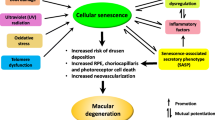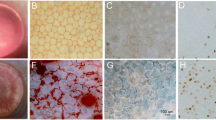Abstract
Purpose
The ocular surface microenvironment changes with aging. However, it remains unclear if cellular senescence influences the ocular surface. We investigated the presence of p16INK4a-expressing senescent cells in healthy human conjunctiva.
Study design
Clinical and experimental.
Methods
Healthy conjunctival tissue samples were obtained from middle-aged and elderly subjects. RT-qPCR was performed to assess the expression of senescence markers CDKN2A (p16INK4a) and CDKN1A (p21CIP1/WAF1) and immunostaining was performed to examine the expression of the senescence marker p16INK4a, stem cell markers Ki67 and p63, tight-junction marker ZO-1.
Results
Our study involved 19 conjunctival tissue samples (10 elderly and 9 middle-aged), mean age [elderly: 75.8 ± 3.7 years (72–81), middle-aged: 52.7 ± 7 years (38–59)], sex (elderly: 3 men, 7 women; middle-aged: 3 men, 6 women). The expression of p16INK4a was significantly increased at the RNA level in the elderly compared to middle-aged (p < 0.05). Positivity rate of p16INK4a was significantly elevated in the elderly (15.0 ± 7.8%) compared to middle-aged (0.2 ± 0.6%) (p < 0.05). Positivity rate of Ki67and p63 was significantly reduced in the elderly (1.7 ± 1.7% and 16.5 ± 9.5%) compared to middle-aged (3.9 ± 1.8% and 24.7 ± 5.7%) (p < 0.05). ZO-1 expression was reduced in tissue samples showing p16INK4a-positivity but retained in tissue samples in which p16INK4a was undetectable.
Conclusions
Senescent cells accumulate with age in the conjunctival epithelium, accompanied by a decrease in Ki67, p63 and ZO-1 expressing cells.





Similar content being viewed by others
References
Kitazawa K, Inomata T, Shih K, Hughes JB, Bozza N, Tomioka Y, et al. Impact of aging on the pathophysiology of dry eye disease: a systematic review and meta-analysis. Ocul Surf. 2022;25:108–18.
Giebel J, Woenckhaus C, Fabian M, Tost F. Age-related differential expression of apoptosis-related genes in conjunctival epithelial cells. Acta Ophthalmol Scand. 2005;83:471–6.
Steinmetz JD, Bourne RRA, Briant PS, Flaxman SR, Taylor HRB, Jonas JB, et al. Causes of blindness and vision impairment in 2020 and trends over 30 years, and prevalence of avoidable blindness in relation to VISION 2020: the Right to Sight: an analysis for the Global Burden of Disease Study. Lancet Glob Health. 2021;9:e144–60.
Maissa C, Guillon M. Tear film dynamics and lipid layer characteristics–effect of age and gender. Cont Lens Anterior Eye. 2010;33:176–82.
Lopez-Otin C, Blasco MA, Partridge L, Serrano M, Kroemer G. The hallmarks of aging. Cell. 2013;153:1194–217.
Nien CJ, Massei S, Lin G, Nabavi C, Tao J, Brown DJ, et al. Effects of age and dysfunction on human meibomian glands. Arch Ophthalmol. 2011;129:462–9.
Parfitt GJ, Xie Y, Geyfman M, Brown DJ, Jester JV. Absence of ductal hyper-keratinization in mouse age-related meibomian gland dysfunction (ARMGD). Aging (Albany NY). 2013;5:825–34.
Parfitt GJ, Brown DJ, Jester JV. Transcriptome analysis of aging mouse Meibomian glands. Mol Vis. 2016;22:518–27.
Yoon CH, Ryu JS, Hwang HS, Kim MK. Comparative analysis of age-related changes in lacrimal glands and Meibomian glands of a C57BL/6 male mouse model. Int J Mol Sci. 2020;21:4169.
Herranz N, Gil J. Mechanisms and functions of cellular senescence. J Clin Invest. 2018;128:1238–46.
Hayflick L, Moorhead PS. The serial cultivation of human diploid cell strains. Exp Cell Res. 1961;25:585–621.
Yokoi N, Komuro A, Nishii M, Inagaki K, Tanioka H, Kawasaki S, et al. Clinical impact of conjunctivochalasis on the ocular surface. Cornea. 2005;24:S24–31.
Neff KD. Conjunctivochalasis. In: Holland EJ, Mannis MJ, Lee WB, editors. Ocular surface disease: cornea, conjunctiva and tear film. Elsevier; 2013. p. 161–6.
Betzler BK, Ding J, Wei X, Lee JM, Grewal DS, Fekrat S, et al. Choroidal vascularity index: a step towards software as a medical device. Br J Ophthalmol. 2022;106:149–55.
Fukui A, Tanaka H, Terao N, Nagata K, Matsumoto A, Kusada N, et al. Changes in choroidal thickness and structure in preeclampsia with serous retinal detachment. J Clin Med. 2023;12:609.
Campisi J, d’Adda di Fagagna F. Cellular senescence: when bad things happen to good cells. Nat Rev Mol Cell Biol. 2007;8:729–40.
Zindy F, Quelle DE, Roussel MF, Sherr CJ. Expression of the p16INK4a tumor suppressor versus other INK4 family members during mouse development and aging. Oncogene. 1997;15:203–11.
Krishnamurthy J, Torrice C, Ramsey MR, Kovalev GI, Al-Regaiey K, Su L, et al. Ink4a/Arf expression is a biomarker of aging. J Clin Investig. 2004;114:1299–307.
Malek G, Campisi J, Kitazawa K, Webster C, Lakkaraju A, Skowronska-Krawczyk D. Does senescence play a role in age-related macular degeneration? Exp Eye Res. 2022;225: 109254.
Li ZY, Chen ZL, Zhang T, Wei C, Shi WY. TGF-β and NF-κB signaling pathway crosstalk potentiates corneal epithelial senescence through an RNA stress response. Aging (Albany NY). 2016;8:2337–54.
Skowronska-Krawczyk D, Zhao L, Zhu J, Weinreb RN, Cao G, Luo J, et al. P16INK4a upregulation mediated by SIX6 defines retinal ganglion cell pathogenesis in glaucoma. Mol Cell. 2015;59:931–40.
Rocha LR, Nguyen Huu VA, Palomino La Torre C, Xu Q, Jabari M, Krawczyk M, et al. Early removal of senescent cells protects retinal ganglion cells loss in experimental ocular hypertension. Aging Cell. 2019. https://doi.org/10.1111/acel.13089:e13089.
Liu C, Cao L, Yang S, Xu L, Liu P, Wang F, et al. Subretinal injection of amyloid-beta peptide accelerates RPE cell senescence and retinal degeneration. Int J Mol Med. 2015;35:169–76.
Feng L, Cao L, Zhang Y, Wang F. Detecting Abeta deposition and RPE cell senescence in the retinas of SAMP8 mice. Discov Med. 2016;21:149–58.
Kojima K, Ueta M, Hamuro J, Hozono Y, Kawasaki S, Yokoi N, et al. Human conjunctival epithelial cells express functional Toll-like receptor 5. Br J Ophthalmol. 2008;92:411–6.
Ueta M, Sotozono C, Kinoshita S. Expression of interleukin-4 receptor alpha in human corneal epithelial cells. Jpn J Ophthalmol. 2011;55:405–10.
Ueta M, Sotozono C, Nishigaki H, Ohsako S, Yokoi N, Mizushima K, et al. Gene expression analysis of conjunctival epithelium of patients with Stevens-Johnson syndrome in the chronic stage. BMJ Open Ophthalmol. 2019;4: e000254.
Ng M, Hazrati LN. Evidence of sex differences in cellular senescence. Neurobiol Aging. 2022;120:88–104.
van Deursen JM. The role of senescent cells in ageing. Nature. 2014;509:439–46.
Paulsen AJ, Cruickshanks KJ, Fischer ME, Huang GH, Klein BE, Klein R, et al. Dry eye in the beaver dam offspring study: prevalence, risk factors, and health-related quality of life. Am J Ophthalmol. 2014;157:799–806.
Farrand KF, Fridman M, Stillman IO, Schaumberg DA. Prevalence of diagnosed dry eye disease in the United States among adults aged 18 years and older. Am J Ophthalmol. 2017;182:90–8.
Dana R, Bradley JL, Guerin A, Pivneva I, Stillman IO, Evans AM, et al. Estimated prevalence and incidence of dry eye disease based on coding analysis of a large, all-age United States health care system. Am J Ophthalmol. 2019;202:47–54.
Furman D, Campisi J, Verdin E, Carrera-Bastos P, Targ S, Franceschi C, et al. Chronic inflammation in the etiology of disease across the life span. Nat Med. 2019;25:1822–32.
Coppe JP, Patil CK, Rodier F, Sun Y, Munoz DP, Goldstein J, et al. Senescence-associated secretory phenotypes reveal cell-nonautonomous functions of oncogenic RAS and the p53 tumor suppressor. PLoS Biol. 2008;6:2853–68.
Franceschi C, Campisi J. Chronic inflammation (inflammaging) and its potential contribution to age-associated diseases. J Gerontol A Biol Sci Med Sci. 2014;69(Suppl 1):S4-9.
Wan W, Zhu W, Wu Y, Long Y, Liu H, Wan W, et al. Grape seed proanthocyanidin extract moderated retinal pigment epithelium cellular senescence through NAMPT/SIRT1/NLRP3 pathway. J Inflamm Res. 2021;14:3129–43.
Bian F, Xiao Y, Barbosa FL, de Souza RG, Hernandez H, Yu Z, et al. Age-associated antigen-presenting cell alterations promote dry-eye inducing Th1 cells. Mucosal Immunol. 2019;12:897–908.
Zhou J, Hou C, Chen H, Qin Z, Miao Z, Zhao J, et al. P16 (I NK 4a) deletion ameliorates damage of intestinal epithelial barrier and microbial dysbiosis in a stress-induced premature senescence model of Bmi-1 deficiency. Front Cell Dev Biol. 2021;9: 671564.
Chang SW, Hu FR. Changes in corneal autofluorescence and corneal epithelial barrier function with aging. Cornea. 1993;12:493–9.
Basisty N, Kale A, Jeon OH, Kuehnemann C, Payne T, Rao C, et al. A proteomic atlas of senescence-associated secretomes for aging biomarker development. PLoS Biol. 2020;18: e3000599.
Zhang Y, Yang M, Zhao SX, Nie L, Shen LJ, Han W. Hyperosmolarity disrupts tight junction via TNF-alpha/MMP pathway in primary human corneal epithelial cells. Int J Ophthalmol. 2022;15:683–9.
Xiao Y, de Paiva CS, Yu Z, de Souza RG, Li DQ, Pflugfelder SC. Goblet cell-produced retinoic acid suppresses CD86 expression and IL-12 production in bone marrow-derived cells. Int Immunol. 2018;30:457–70.
Ko BY, Xiao Y, Barbosa FL, de Paiva CS, Pflugfelder SC. Goblet cell loss abrogates ocular surface immune tolerance. JCI Insight. 2018;3: e98222.
Acknowledgements
We wish to thank Shigeru Kinoshita for the scientific suggestions. This research was partially supported by JSPS Grant-in-Aid for Scientific Research Grant Number 21K09748.
Author information
Authors and Affiliations
Corresponding author
Ethics declarations
Conflicts of interest
Y. Tomioka, None; K. Kitazawa, Seminars (AMO, Santen, Senju); K. Numa, None; J-W B. Hughes, None; N. Yokoi, Seminars (Lumenis Be, Santen, Senju), Patents (planned, pending or issued) (Rexxam and Kyoto Prefectural Public University Corporation owe the patent for an ophthalmic device related to the method of dry eye classification, Kowa and Kyoto Prefectural Public University Corporation owe the patent for the method and device for evaluating tear film dynamics); C. Sotozono, Grant to the author’s institution (Santen, Alcon, Senju, Otsuka, Nitto Medic, Nitten, Kowa, CorneaGen), Seminars (Otsuka, Santen, Senju, TOA).
Additional information
Publisher's Note
Springer Nature remains neutral with regard to jurisdictional claims in published maps and institutional affiliations.
Corresponding Author: Koji Kitazawa
About this article
Cite this article
Tomioka, Y., Kitazawa, K., Numa, K. et al. The existence of senescent cells in conjunctival epithelium from elderly individuals. Jpn J Ophthalmol 68, 157–165 (2024). https://doi.org/10.1007/s10384-023-01047-x
Received:
Accepted:
Published:
Issue Date:
DOI: https://doi.org/10.1007/s10384-023-01047-x




